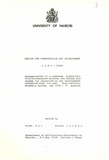| dc.description.abstract | This document "Design for Conservation and
Development" summarises results of a joint
teaching/learning programme in conservation
and redevelopment - as a part of a development
oriented architectural education programme.
It consists of a historical studies and measured
drawing programme and a design programme
using the measured drawings of an existing
house which will be converted to serve as
a Study and Research Centre for the University
of Nairobi. The innovation of this programme
is our proposition to use a historical
studies and measured drawing programme as input
into a design programme, which aims at the
conservation and revitalization of the existing
structures .
A study programme of this nature should be
located within a strong cultural context.
Lamu offered an excellent choice.
Along the coastline of the Indian Ocean in Kenya
and East Africa as a whole, urban settlements
have evolved for over a thousand years. In
past centuries they were poles of regional and
international trade and cultural exchange
across the oceans. These early East African
settlements gradually evolved into urban
centres - seats of the Swahili Culture,
made up of local and foreign ingredients, that
co-alesced into a culture of strong east
african identity.
Search for identity in settlement organisation
and architectural expression is a challenge
for the student and teacher of architecture,
here and elsewhere. Visitors to most african
cities are confronted with anonymous
internationally styled agglomerations of
luxurious buildings, or equally anonymous
collections of makeshift shelters, where rural
immigrants try to establish a foothold, close
to areas of "development" concentrations.
Critical visitors to the Department of
Architecture posed the question as to what we
do towards the development of an architectural
identity in the country. Such provocative
questions must be faced, if we are to achieve
something more than monotonous shelter for
unknown people in locations we seem to know
little about, or merely semblance of "style"
and not content.
An important educational tool towards the
understanding of identity in settlement pattern
and built form are historical studies and
measured drawing in a strong cultural context.
Ideally, such studies should take the student
away from his habitual environment, where he
is in danger of loosing his capacity to
question and analyse the forces which shaped his
place of residence. Historical studies should
oblige the student to understand the variety | en_US |



